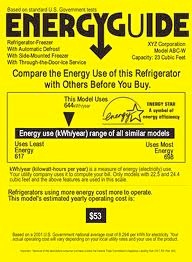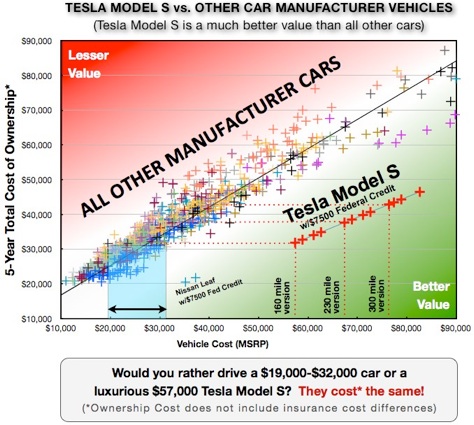New Index Reveals New Perspective on Car Value






TM

News
New Car Value Index Reveals Best Deals
Index to News Articles
Jan 08, 2012 - Model S Signature Cars Sold Out in the USA!
Jan 05, 2012 - New Car Value Index Reveals Best Deals
Dec 21, 2011 - The Signature Model S has a $3,550 Premium
Dec 20, 2011 - Model S Options & Pricing Observations
Dec 10, 2011 - Model S Options may be disclosed on Dec 15?
Nov 28, 2011 - Tesla Reinvents the Car Buying Experience
Tuesday, Jan 5, 2012 by Max Mindel

HAVE I GOT A DEAL FOR YOU!
Today, the least expensive Porsche, sells for $48,000 while a basic Toyota Camry sells for $21,000. If I told you that I’d sell you a brand new 2012 Porsche for the same price as a brand new Toyota Camry, wouldn’t you grab that opportunity in an instant?
NOT SUCH A GREAT DEAL AFTER ALL
Most people would. But what if I told you thereafter that the Porsche uses very expensive fuel and that the maintenance costs are 5 times what maintenance costs on a Toyota Camry? If you discovered that instead of spending $3,500 per year on fuel that you would have to spend $15,000, and that your maintenance costs would be $5000 per year instead of $600. At that point, you’d definitely lose interest instantly. After all, even though the car would be discounted by nearly $30,000, you would in a 5-year period end up spending $75,000 on fuel alone and $25,000 on maintenance; that’s $100,000 in total!
This is of course a intentional exaggeration but its purpose is to illustrate a point that most car shoppers never stop to consider; and that is... What a car costs does not matter, nor do the payments you will be making if you finance it. If someone did offer you a great deal on a car, would you even stop to consider how much it would cost you to operate it over the period that you plan to use it? I think the answer for most of us is, “probably not.”
AUTOMOBILE OPERATING COSTS MATTER



A REALLY GREAT DEAL FOR REAL THIS TIME!
What if someone offered you a very expensive car that costs almost $60,000 but told you that to fuel it, it would only cost $300 per year instead of $3500 per year. What if you also found out that at most, you’d only have to change the brakes on it every 3 to 4 years thus reducing some of you maintenance costs? You still would probably think, wait...it’s still a $60,000 car, which I know I can’t afford! But, what if you found out that despite the higher sticker price on the car, that the cost to operate it would be the same or less than the $20,000 to $30,000 car you were planning to buy? If you were told that after using the car for 5 years and maintaining it, paying for future repairs, fueling it, and thereafter selling it, that you would end up spending less money or the same money as that other cheaper car you were considering? Wouldn’t that interest you?
Which is the better deal? The car that costs $60,000 that you get to drive for 5 years after which you will have spent $32,000, or a $26,000 more budget car for which you also would still spend the same $32,000! Either way, at the end of those 5 years you would end up having spent the same amount of money, but had a completely different experience.
If we examine this, it seems that the cost to use the $60,000 car was half the price of the car, while the cost to operate the $26,000 car was almost 25% more than the cost of the car itself! So if the operating cost of a car, divided by the price of a car gives a lower number, the car is clearly a better deal.
NEW INDEX REVEALS CAR VALUE
We decided to examine this for all the cars we’ve looked in Teslanomics and we discovered something very interesting. If you look at the graph above, you’ll notice that all the gasoline cars are clustered in a line that almost goes at a 45 degree angle. It seems that gasoline-fueled cars have an operating cost (depreciation, fuel, maintenance, and repairs) about equal to or 50% higher than the price of the car itself!

So we divided these two figures (operating cost/car price) and came up with an index for each car. The higher the number, the more it costs to operate, while the lower the number, the cheaper it is to operate compared to its cost. In the example above, we really were comparing a $57,400 Tesla Model S, to a $25,945 Volkwagen GTI Hatchback. If you were given the choice of driving a luxury car like the Tesla Model S or a VW GTI for the same exact costs, clearly the Tesla Model S is a better value, and that is clear in the fact that the index we obtained in dividing the car’s operating cost by its price was .58, while it was 1.22 for the VW GTI.
We call this index the CVI or the Car Value Index. When you view individual car manufacturers vs Tesla Model S in the pages here in TeslaRumors Teslanomics section, you will see in the list for each car in the right-most column which car has the lowest (best) CVI. Both the Nissan Leaf and the Tesla Model S have excellent CVI’s, and he $7500 Federal Tax Credit helps that. But since that will ultimately one day go away, we calculated the CVI without the credit and found that the Tesla Model S’ CVI still retains an excellent CVI in going from .58 to .68 while the Nissan Leaf becomes less appealing with a CVI of about 1.



Copyright © 2012 TeslaRumors.com All rights reserved.


The Signature Model S is now Sold Out!
New Car Value Index Reveals Best Deals
The Signature Model S has a $3,550 Premium
Model S Options and Pricing Observations
Modei S Options may be disclosed on Dec 15
Tesla Reinvents the Car Buying Experience
Did I realy just buy a car online?
Tesla Opens 3 News Stores in Malls







TeslaRumors.com is not affiliated with Tesla Motors, Inc.
The Tesla Motors logo is a registered trademark of Tesla Motors, Inc.
TM
VISITORS

